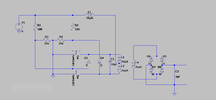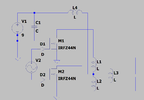Hi, I'm pretty new to electronics and trying to get a HV low amperage DC power supply, somewhere in the range of 500-1kV.
I have a basic ZVS set up, hooked up to a transformer and a rectifier. I was hoping to get an arc through the gap to make sure it works. With a 1:100 ratio on the coil it should produce around 900V, which should be enough to ionize at least 2mm of air. From what I understand, each half of the center tapped coil should generate a half sine wave, out of phase with each-other? That should generate a sine wave with 900V peaks on the other side of the transformer? With the rectifier and capacitor it should smooth out.
My question is is a 9v battery enough to drive this circuit and get HVDC? Or am I misunderstanding how the circuit works?
I have a basic ZVS set up, hooked up to a transformer and a rectifier. I was hoping to get an arc through the gap to make sure it works. With a 1:100 ratio on the coil it should produce around 900V, which should be enough to ionize at least 2mm of air. From what I understand, each half of the center tapped coil should generate a half sine wave, out of phase with each-other? That should generate a sine wave with 900V peaks on the other side of the transformer? With the rectifier and capacitor it should smooth out.
My question is is a 9v battery enough to drive this circuit and get HVDC? Or am I misunderstanding how the circuit works?




